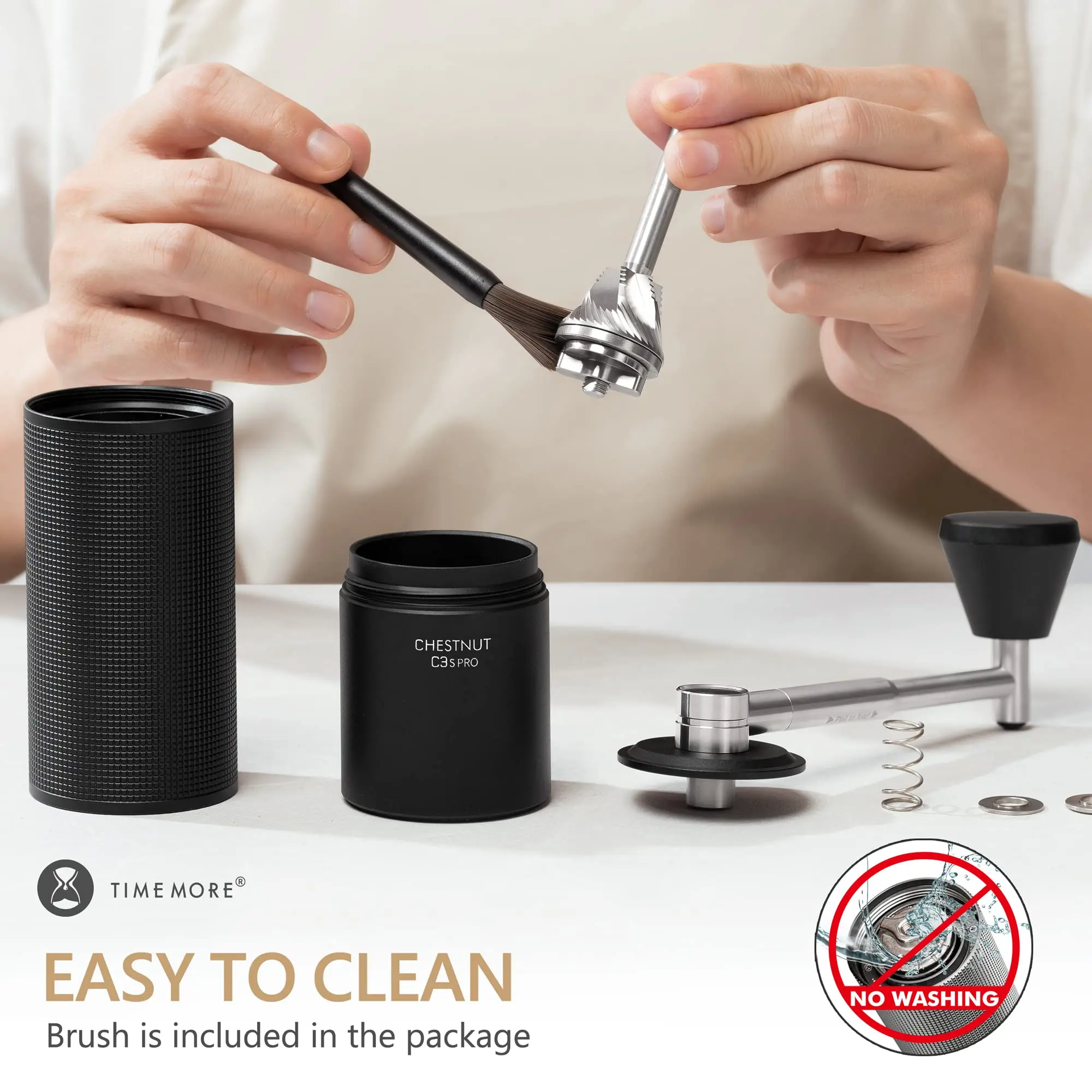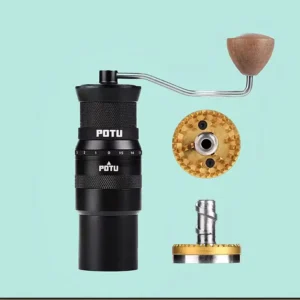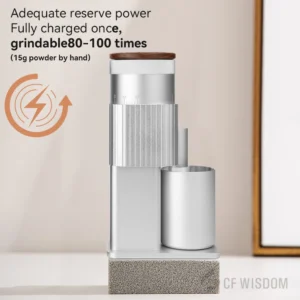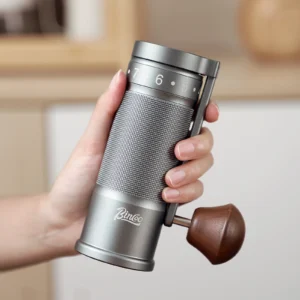Why Your Wrist Deserves a Break: The Importance of Easy Cranking
Making the perfect cup of coffee at home starts with freshly ground beans, but many coffee enthusiasts find themselves frustrated with traditional hand grinders that turn this enjoyable ritual into a literal pain. The struggle is real:
- Wrist and hand fatigue after just one cup’s worth of grinding
- Inconsistent grounds due to unstable or difficult cranking
- Morning frustration when you just want your coffee quickly
- Abandoned hand grinders collecting dust after the novelty wears off
An easy-to-crank hand grinder isn’t just about comfort—it’s about sustainability of your coffee ritual. When grinding becomes effortless, you’re more likely to continue enjoying fresh grounds daily rather than reverting to pre-ground coffee or an electric grinder that sacrifices control.
The best hand grinders balance the meditative manual control coffee enthusiasts love with a physical experience that doesn’t feel like a workout. This balance comes from thoughtful engineering and quality components that work together to reduce resistance and create a smooth motion.
Understanding proper mastering espresso precision grind settings is crucial, but equally important is having a grinder that makes achieving those settings comfortable. The right hand crank coffee grinder can transform your morning routine from a chore to a pleasure.
The Anatomy of Effortless Grinding: What Makes a Crank Truly “Easy”
Not all hand grinders are created equal when it comes to the cranking experience. Several key mechanical elements work together to create that satisfying, smooth motion that makes manual grinding a pleasure rather than a chore:
Bearing Systems
The difference between a grinder that glides and one that grinds to a halt comes down to its bearings:
- Single bearing systems provide basic support but may wobble under pressure
- Dual bearing systems stabilize the shaft from both ends, dramatically reducing resistance
- High-quality steel bearings minimize friction and provide longevity compared to plastic components
Burr Design and Sharpness
The cutting surfaces at the heart of your grinder significantly impact cranking effort:
- Sharp, precision-cut burrs slice through beans efficiently rather than crushing them
- CNC-machined burrs maintain consistent spacing for reduced resistance
- Burr coating can reduce friction and resistance during grinding
Handle Length and Ergonomics
The handle is your primary point of contact with the grinder:
- Longer handles (5-6 inches) provide better leverage, requiring less force
- Ergonomic grips distribute pressure across the palm rather than concentrating it
- Counterbalanced handles reduce wobble and create smoother rotation
Shaft Stability and Alignment
A perfectly aligned central shaft prevents energy waste:
- Tight tolerances between components prevent wiggling that creates resistance
- Strong, straight shafts won’t bend under pressure
- Quality connections between handle and shaft eliminate “play” in the mechanism
These premium components justify the investment in a higher-quality hand grinder. The difference between struggling through a 3-minute grind session and enjoying a quick 45-second process is significant when you’re using your grinder daily. The manual and automatic espresso grinder settings may differ, but the principle remains: quality components lead to superior performance.
Premium Performers: Our Top Easy-Crank Hand Grinders
At Savor Suite, we thoroughly test every grinder in our collection to ensure exceptional performance. Our testing process involves grinding multiple coffee varieties at different settings while measuring effort required, time needed, and consistency of results. Here are our standout performers for effortless cranking:
The Balanced Performer
This grinder features dual stainless steel bearings that create remarkably smooth operation. The extended 5.5-inch wooden handle provides excellent leverage, allowing you to grind 20 grams of coffee beans in under a minute with minimal effort. The stabilized shaft eliminates wobble, making the grinding experience feel controlled and precise. Particularly impressive is how it maintains smooth operation even at finer espresso settings where many competitors become difficult to turn.
The Travel Champion
Designed with portability in mind, this compact grinder doesn’t sacrifice cranking comfort. Its folding handle extends to provide surprisingly good leverage, while the precision bearings ensure smooth rotation despite the smaller size. The reinforced connection between handle and shaft eliminates the common problem of wiggle in portable models. During testing, we found it required about 25% less effort than other travel-sized competitors while delivering consistent grounds.
The Precision Powerhouse
For those focused on espresso, this premium grinder offers an exceptionally smooth cranking experience even at the finest settings. The combination of military-grade bearings and perfectly aligned burrs creates almost frictionless turning. The substantial weight (1.2 lbs) provides stability, eliminating counter-pressure that would otherwise require additional grip strength. Our testing showed this model required the least effort of all tested grinders while producing the most consistent results across all grind sizes.
The Daily Workhorse
This all-purpose grinder strikes the perfect balance between affordability and smooth operation. Its triple-bearing system creates stability that competitors at similar price points can’t match. The ergonomic handle with silicone grip prevents slipping while reducing hand fatigue during longer grinding sessions. While slightly more effort is required than our premium models, it still outperforms most hand grinders on the market for smoothness and consistency.
Understanding the ultimate espresso grind size chart is essential for perfect extraction, and these grinders make achieving those precise settings much more comfortable. Browse our collection of manual burr mills to find the perfect match for your brewing style.
Burr Design: The Hidden Hero of Smooth Grinding
The burr assembly is where the actual coffee grinding happens, and its design significantly impacts how much effort you’ll exert with each turn of the handle. A well-designed burr set can make the difference between effortless grinding and a frustrating workout.
Conical vs. Flat Burrs for Hand Cranking
- Conical burrs typically require less effort because beans are guided naturally into the grinding area
- Flat burrs may offer exceptional consistency but often demand more force, especially for finer settings
- The angle of conical burrs (typically 38-40 degrees) affects both grinding efficiency and required effort
Material Considerations
The material of your burrs affects both grinding experience and longevity:
- Stainless steel burrs cut more efficiently through beans, requiring less initial force
- Ceramic burrs stay sharper longer but may require more effort when new
- Titanium-coated burrs reduce friction for smoother grinding while extending longevity
Manufacturing Precision
The precision with which burrs are manufactured directly correlates to grinding ease:
- CNC-machined burrs with tolerances under 0.1mm create smoother grinding action
- Perfectly centered burrs reduce wobble and resistance
- Well-matched upper and lower burrs prevent beans from getting stuck and causing sudden resistance
The technical aspects of manual flat burr grinder mechanics reveal why precision manufacturing makes such a difference in the physical effort required during grinding. When burrs move together without friction or misalignment, you’ll feel the difference in every turn of the handle.
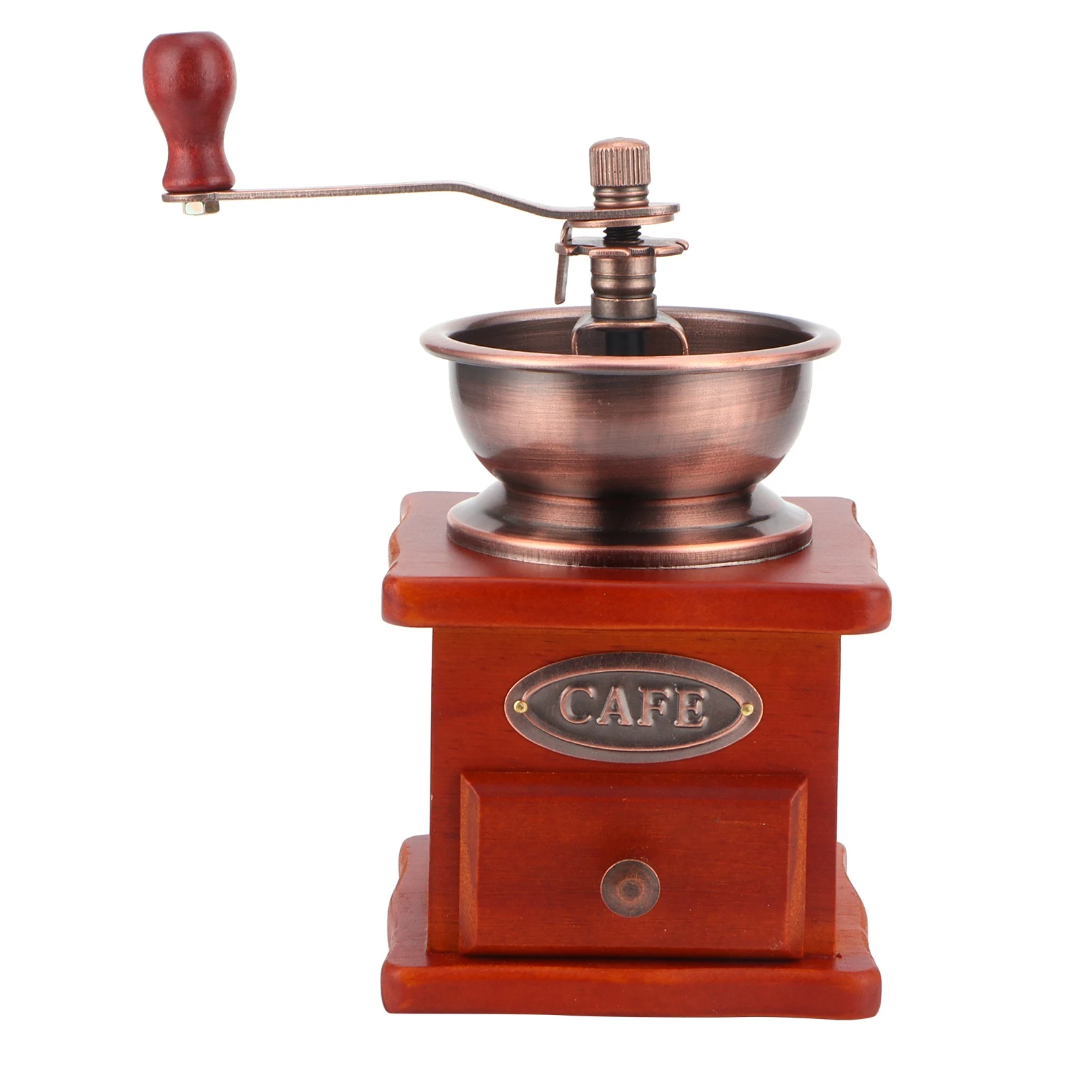
Ergonomic Excellence: Handle Design for Maximum Comfort
The handle is your primary interface with any hand grinder, and its design dramatically affects user comfort and efficiency. Smart ergonomics can reduce perceived effort even when grinding resistance remains the same.
The Science of Leverage
- Handles ranging from 4.5 to 6 inches provide optimal leverage for most users
- Each additional inch of handle length significantly reduces required force
- The distance between grip and center of rotation creates mechanical advantage
Materials and Grip Design
- Wooden handles provide natural warmth and comfort for extended grinding
- Silicone or rubber overlays prevent slipping without requiring excess grip strength
- Contoured grips that fit the natural shape of the palm reduce pressure points
- Knob-ended handles allow two-finger operation for fine control
Fixed vs. Folding Considerations
- Fixed handles provide maximum stability and consistent leverage
- Folding handles offer convenience for travel but must lock firmly to prevent wobble
- The connection point between handle and shaft is critical for stability in folding designs
The best all metal hand grinders combine durability with ergonomic handle designs that make daily grinding a pleasure rather than a chore. Remember that personal preference plays a role here—what feels comfortable in one person’s hand may not work as well for another.
Stability Matters: How Base Design Affects Grinding Effort
A stable grinder base may seem like a minor detail, but it significantly impacts how much energy you expend while grinding. When your grinder stays firmly in place, all your effort goes into grinding beans rather than stabilizing the unit.
Anti-Slip Features That Save Energy
- Rubber or silicone base rings create friction against countertops
- Wider bases (3+ inches) distribute weight for better stability
- Textured surfaces on the grinder body improve grip without requiring excess hand pressure
Ideal Proportions for Different Hand Sizes
- Grinders with diameters of 2-3 inches fit comfortably in most hands
- Height-to-width ratio affects stability—too tall and narrow creates tipping hazards
- Models with slightly tapered bodies naturally nest into the palm
Weight Distribution
- A balanced center of gravity prevents tipping during grinding
- Bottom-weighted designs remain planted on countertops
- 12-16 ounce total weight typically offers ideal balance between stability and portability
Our collection of manual coffee grinders in stainless steel offers excellent stability due to their substantial weight and thoughtful base design. When evaluating grinders, always consider how they’ll behave on your counter—a stable grinder translates to easier cranking and less wasted energy.

Who Benefits Most? Finding Your Perfect Easy-Crank Match
Different coffee enthusiasts have unique needs when it comes to hand grinders. Understanding your specific requirements will help you select the perfect easy-crank model for your situation.
For Users With Physical Limitations
If you experience joint pain, arthritis, or limited grip strength, prioritize these features:
– Extended handles (5.5+ inches) that maximize leverage
– Multi-bearing systems that minimize resistance
– Wider grinder bodies that require less gripping force to stabilize
– Ergonomic handles with contoured grips that distribute pressure evenly
Daily vs. Occasional Users
Daily Grinders should invest in:
– Premium bearings that maintain smooth operation over thousands of uses
– Durable burrs that stay sharp longer
– Easily disassembled designs for regular cleaning
Occasional Users might prioritize:
– Value-oriented options with good but fewer bearings
– Versatile grind settings for different occasional brewing methods
– Simpler designs that require less maintenance
Home vs. Travel Use
Home-based brewers benefit from larger, heavier grinders with fixed handles and maximum stability. Those who travel frequently should look to best hand grinders for travel brewing that offer folding handles and compact dimensions without sacrificing too much cranking comfort.
Brewing Method Considerations
Your preferred brewing method also affects your ideal grinder choice:
– Espresso specialists need grinders with exceptional stability at fine settings where resistance is greatest
– Pour-over enthusiasts benefit from consistent medium grinds that typically require moderate cranking effort
– French press users enjoy the easiest grinding experience at coarser settings
Fine Adjustment Hand Grinder, Precision Manual Grinder, Travel Coffee Grinder
Price range: $185.11 through $494.63 Select options This product has multiple variants. The options may be chosen on the product pageHand Burr Grinder, Hand Crank Coffee Grinder, Manual Espresso Grinder, Portable Coffee Grinder
Price range: $262.72 through $300.22 Select options This product has multiple variants. The options may be chosen on the product pageManual Burr Mill, Manual Coffee Grinder Stainless Steel, Manual Coffee Mill Grinder, Mechanical Coffee Grinder
Price range: $127.26 through $130.32 Select options This product has multiple variants. The options may be chosen on the product pageHand Burr Grinder, Manual Coffee Grinder Stainless Steel, Precision Manual Grinder
Price range: $183.64 through $187.52 Select options This product has multiple variants. The options may be chosen on the product page
Beyond the Crank: Maintenance Tips for Long-Term Smooth Operation
Even the smoothest-cranking grinder will develop resistance over time without proper care. Follow these maintenance practices to keep your grinder operating effortlessly for years to come:
Regular Cleaning Schedule
Clean your grinder every 1-2 weeks for daily users or after every 5-7 uses for occasional users. Remove coffee oils and fine particles that create drag on moving parts.Proper Burr Cleaning
Use a small brush to clean between burr teeth where coffee particles get trapped. Compressed air can help remove particles from hard-to-reach areas without disassembly.Bearing Maintenance
While most premium bearings are sealed and require no lubrication, check your manufacturer’s recommendations. Some models benefit from a tiny amount of food-safe lubricant applied annually.Alignment Check
If grinding becomes more difficult over time, check for burr alignment issues. Uneven wear can create “hot spots” of resistance. Most quality grinders allow for recalibration.Handle Connection Care
The connection between handle and shaft often loosens first. Check this connection monthly and tighten as needed to prevent wobble that creates resistance.
Our detailed manual burr grinder maintenance guide provides step-by-step instructions for keeping your grinder in peak condition. Remember that a well-maintained grinder not only cranks more easily but also produces more consistent grounds for better coffee.
Is It Worth the Investment? Comparing Easy-Crank Grinders to Alternatives
When considering the premium price of high-quality hand grinders with easy-crank mechanisms, it’s natural to question the value proposition compared to alternatives.
Manual Premium vs. Entry-Level Electric
Premium Manual Grinders:
– Superior grind consistency compared to budget electric models
– Significantly longer lifespan (10+ years vs. 2-3 years for budget electric)
– No electricity needed and completely portable
– Quiet operation that won’t disturb household members
– Greater physical connection to the brewing process
Entry-Level Electric Grinders:
– Require no physical effort
– Generally faster grinding time
– Often less consistent grind quality in the $60-100 range
– More prone to breakdown with more components that can fail
Long-Term Value Consideration
A quality hand grinder with easy-crank design typically costs $120-200 but will last for many years. Assuming daily use over 10 years, this breaks down to just pennies per use. Replacement parts are usually available, and maintenance is simple.
When Each Option Makes Sense
Choose a premium manual grinder with easy crank when:
– You appreciate the ritual and connection to your coffee
– You value precision and control over convenience
– You travel frequently or have limited counter space
– You enjoy the quieter grinding experience
Choose an electric grinder when:
– Physical limitations make any hand grinding impossible
– Time efficiency is your absolute top priority
– You frequently prepare coffee for large groups
The precision manual grinders in our collection represent an excellent long-term investment for coffee enthusiasts who value both the quality of their coffee and the experience of preparing it.

Frequently Asked Questions About Easy-Crank Hand Grinders
How much easier is a premium hand grinder compared to budget models?
Premium models with quality bearings and aligned burrs typically require 30-50% less force to operate. The difference is most noticeable at finer settings and when grinding dense, light-roast beans.
Do easy-crank grinders sacrifice grind consistency?
Not at all. The engineering that makes cranking easier—precision bearings, aligned shafts, and quality burrs—actually improves consistency by reducing wobble and maintaining stable grinding surfaces.
How long does it take to grind enough coffee for one cup with an easy-crank model?
With most premium easy-crank grinders, you can expect to grind 20 grams of coffee (enough for a single cup) in 30-45 seconds. Budget grinders might take 1-2 minutes for the same amount.
Are easy-crank grinders worth the extra investment?
If you grind coffee daily, absolutely. The difference in experience compounds over time, and many users who upgrade report they actually start grinding fresh more often because the process becomes enjoyable rather than tedious.
Can I adjust an existing grinder to make it easier to crank?
While some maintenance can improve performance, the fundamental ease of cranking comes from the bearing system and overall design. Minor improvements can be made through cleaning, lubrication (if recommended by the manufacturer), and ensuring all components are properly tightened.
For those focused on espresso, understanding espresso grind settings for the perfect shot becomes much easier when you’re not struggling against a difficult crank mechanism.
Our Methodology: How We Test for Easy Cranking
At Savor Suite, we take a systematic approach to evaluating the cranking ease of each grinder in our collection:
Objective Measurements
- Timed grinding sessions: We measure how long it takes to grind 20g of coffee at various settings
- Rotation count: We track how many handle rotations are needed to complete the grind
- Torque requirements: Using specialized equipment, we measure the force needed to turn the handle
Controlled Testing Conditions
All grinders are tested with:
– The same coffee bean variety and roast level
– Identical quantity measurements
– Multiple grind settings from coarse to fine
– Both new (out of box) condition and after a break-in period
– Multiple testers with different hand strengths and sizes
Subjective Evaluation
We complement technical measurements with user experience assessment:
– Hand fatigue after continuous use
– Comfort of grip and handle motion
– Stability during operation
– Overall satisfaction with the grinding experience
This comprehensive approach ensures our recommendations truly deliver on the promise of an easy cranking experience across various users and scenarios.

